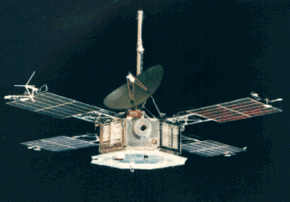- Mariner 5
-
Mariner 5 
Operator JPL - NASA Mission type Fly-by Flyby of Venus Launch date 14 June 1967 at 06:01:00 UTC Launch vehicle Atlas-Agena D Mission duration June 14, 1967 to November, 1967 COSPAR ID 1967-060A Mass 244.9 kg Power 170 W Orbital elements Periapsis 4,000 km from Venus Mariner 5 (Mariner Venus '67) was a spacecraft of the Mariner program that carried a complement of experiments to probe Venus' atmosphere by radio occultation, measure the hydrogen Lyman-alpha (hard ultraviolet) spectrum, and sample the solar particles and magnetic field fluctuations above the planet. Its goals were to measure interplanetary and Venusian magnetic fields, charged particles, plasmas, radio refractivity and UV emissions of the Venusian atmosphere.
Mariner 5 was actually built as a backup to Mariner 4, but after the success of the Mariner 4 mission, it was modified for the Venus mission by removing the TV camera, reversing and reducing the four solar panels, and adding extra thermal insulation.
It was launched toward Venus on June 14, 1967 from Cape Canaveral Air Force Station Launch Complex 12 and flew by the planet on October 19 that year at an altitude of 3,990 kilometres (2,480 mi). With more sensitive instruments than its predecessor Mariner 2, Mariner 5 was able to shed new light on the hot, cloud-covered planet and on conditions in interplanetary space.
Radio occultation data from Mariner 5 helped to understand the temperature and pressure data returned by the Venera 4 lander, which arrived at Venus shortly before it. After these missions, it was clear that Venus had a very hot surface and an atmosphere even denser than expected.
The operations of Mariner 5 ended in November 1967 and it is now defunct in a heliocentric orbit.
Further communication attempts
Further communication attempts were tried, in a joint spacecraft solar wind / solar magnetic fields investigation with Mariner 4, back in communication with Earth after being out of telemetry for about a year or more around superior conjunction. During the experiment, both spacecraft were going to be on the same idealized magnetic field spiral carried out from the sun by the solar wind.
Between April and November 1968 NASA tried to reacquire Mariner 5 to continue probing interplanetary conditions. Attempts to reacquire Mariner 5 during June, July, and early August 1968 yielded no spacecraft signal.
On October 14, the receiver operator at DSS 14 obtained a lock on the Mariner 5 signal. A carrier wave was detected, but outside expected frequency limits and varying in wavelength. Signal strength changes indicating the spacecraft was in a slow roll. Nevertheless, it was possible to lock the spacecraft to an uplink signal, but no response was observed to any commands sent to it. Without telemetry and without any signal change in response to commands, there was no possibility to repair or continue to use the spacecraft. Operations were terminated at the end of the track from DSS 61 at 07:46 GMT on November 5, 1968.
Instruments
- Two-Frequency Beacon Receiver
- S-Band Occultation
- Helium Magnetometer
- Interplanetary Ion Plasma Probe for E/Q of 40 to 9400 Volts
- Celestial Mechanics
External links
- Mariner 5 Mission Profile by NASA's Solar System Exploration
- Mariner Venus 1967 Final Project Report
Mariner program Mariner 1 · Mariner 2 · Mariner 3 · Mariner 4 · Mariner 5 · Mariner 6 and 7 · Mariner 8 · Mariner 9 · Mariner 10Previous mission: Mariner 4 — Next mission: Mariner 6 and 7 Spacecraft missions to Venus Flybys 
Orbiters Descent probes Landers Balloon probes Future missions Proposed missions Venus In-Situ Explorer (study)See also Bold italics indicates active missions Science instruments on satellites and spacecraft Radio science
(planetary
occultation)Cassini–Huygens · Mariner 2 · Mariner 3 · Mariner 4 · Mariner 5 · Mariner 6 and 7 · Mariner 9 · Mariner 10 · Voyager 1 · Voyager 2 · MESSENGER · Venus Express · Mars ExpressRadiometer Near Earth satelliteInfrared (IR)Near Earth satelliteInterplanetaryUltraviolet (UV) ·Near Earth satelliteSpectro-
photometersLong wavelengthInterplanetaryNear Earth satelliteInterplanetaryInterplanetaryMagnetometer Near Earth satelliteInterplanetaryInterplanetaryMariner 2 · Mariner 4 · Mariner 5 · Mariner 10 · Cassini–Huygens · Venus Express · MESSENGER · MagsatHelium vapor1, 2InterplanetaryParticle
detectorsIon detectorsNear EarthInterplanetaryNeutral particle detectorInterplanetaryCategories:- Mariner program
- Venus spacecraft
- 1967 in spaceflight
- Inactive extraterrestrial probes
- Artificial satellites orbiting Sun
Wikimedia Foundation. 2010.

